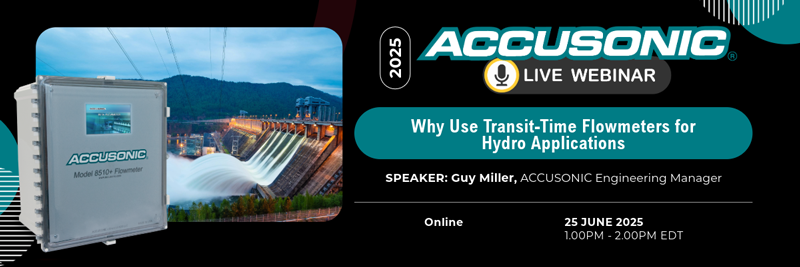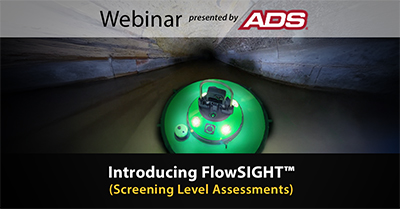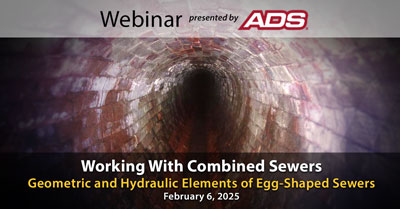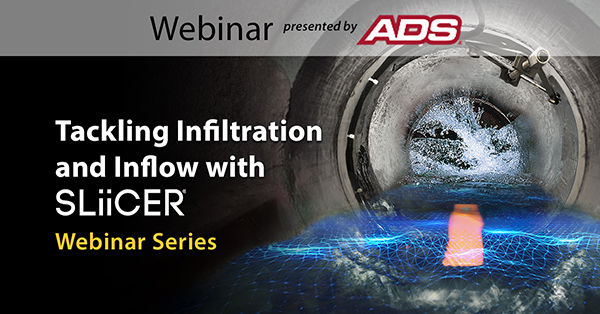


(ACCUSONIC) Why Use Transit-Time Flowmeters for Hydro Applications?
June 25, 2025
We’ll explore the Transit-Time Principle of Operation, real-world applications, and a variety of flowmeter and transducer solutions. Discover why Transit-Time technology is ideal for hydro applications—whether you’re in Municipal Water, Hydropower, or Industrial Manufacturing. Our systems are engineered for pipes and channels of all sizes and shapes.
SPEAKER: Guy Miller
TIME: 30 Minutes

Introducing FlowSIGHT™
Large sewers (>36”) are inherently challenging for traditional CCTV methods of inspection due to access, significant traffic control requirements, and flow velocities. Screening Level Assessments with ADS® FlowSIGHT™ are changing the game.
PART 1: Leveraging Screening Level Assessments (SLA) to Prioritize & Justify Next Steps of Action | March 25, 2025
Leveraging rapid sewer screening methods is the focus of this webinar. We will discuss a programmatic methodology to use screenings to assist in prioritizing further diagnostic inspections, or decisions such as MSI. Our free-floating, untethered devices enable rapid visual screening of large diameter sewers. Clients who have leveraged not only this innovative methodology, but our FlowSIGHT service offering have been able to inspect portions of their collection systems that have never been inspected, while saving money by reducing operational resources needed to deploy expensive diagnostics technologies.
SPEAKER: Rob Lee
TIME: 30 minutes
PART 2: Key Insights from Screening Level Assessment (SLA): Deliverables That Drive Success | May 21, 2025
Review next step actions our clients can take from the findings of a screening level assessment along with a deeper look into the specific deliverables our clients can expect from FlowSIGHT. We have several real-world examples from performing this service commercially for 5 years that demonstrate the success of this technology and methodology.
SPEAKER: Drew McKenzie
TIME: 30 minutes

Working with Combined Sewers: Geometric and Hydraulic Elements of Egg-shaped Sewers
February 6, 2025
Do you like sewers? Do you like geometry? Do you like history? If you answered “yes” to at least two of these questions, then this webinar is for you.
Combined sewers are designed and constructed with a wide variety of sewer cross sections. While the circular section is most common, other non-circular sections have also been used over the years. Therefore, working with combined sewers requires an understanding of the geometric and hydraulic elements of these non-circular sections when encountered. The egg-shaped sewer section is the focus of this webinar. Descriptions of the most common egg-shaped sewer sections are provided, and historical perspectives regarding their development and application are discussed. The geometric and hydraulics elements of these egg-shaped sections are then defined, and the equations for the wetted area, wetted perimeter, and surface width for sewers flowing partially full are provided and validated. The result is a concise reference for wastewater professionals working with egg-shaped sewers in combined sewer systems.
SPEAKER: Kevin Enfinger, P.E.
TIME: 1 hour

Tackling Infiltration and Inflow with SLiiCER®: Series
Have an infiltration and inflow (I/I) problem? You are not alone. Most wastewater collection systems do. Resolving comprehensive I/I problems starts by evaluating flow monitor and rainfall data as part of an I/I study. This multi-part webinar series is taught by experienced professionals where you will learn how to apply SLiiCER – our Cloud-based I/I analytics tool – to understand and prioritize I/I problems in your wastewater collection system.
SPEAKER: Kevin Enfinger, P.E.
TIME: 1 hour
PART 1: SLiiCER Overview – The Big Picture | August 29, 2024
This is a general overview of SLiiCER and demonstrates how it provides I/I insights to wastewater professionals. This webinar discusses the “big picture” and highlights the capabilities and time savings that SLiiCER brings to the table.
PART 2: Understanding Dry Weather Flows | September 26, 2024
Part 2 discusses techniques to extract dry weather flows from flow monitor and rainfall monitor data and how to use SLiiCER to distill them into a variety of insights including minimum, average, and maximum dry day flows, peaking factors, wastewater production, and groundwater infiltration.
PART 3: Understanding Wet Weather Flows | November 14, 2024
Part 3 discusses techniques used to evaluate rainfall dependent infiltration and inflow (RDII) and shows how to leverage SLiiCER to run the calculations, assess the results, and make any adjustments needed.
